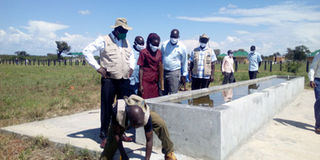Prime
Govt opens cattle labs, dams in Teso

The Minister of Agriculture, Mr Vincent Ssempiija (2nd left), commissions a cattle holding ground at Getom in Katakwi District at the weekend. PHOTO SIMON | PETER EMWAMU
What you need to know:
- Mr Seraphine Alia, the Katakwi chief administrative officer, welcomed the projects, saying the district has hundreds of thousands of cattle, which can supply beef for export.
- Mr Alia added that before the cattle markets were closed, traders came from as far as Kenya, Sudan and Somalia.
The government has commissioned a multi-billion livestock production and marketing infrastructure in Teso and Karamoja sub-regions to enable pastoralists improve the quality and quantity of livestock.
Dr Juliet Sentumbwe, the director of animal resources at the Ministry of Agriculture, told Daily Monitor at the commissioning in Katakwi District at the weekend that the projects under Regional Pastoral Livelihood Resilience Project (RPLRP) consist of cattle holding centres, laboratories, valley dams, communal cattle crushes for spraying and slaughter shades.
Ms Sentumbwe said the facilities are part of the broader plan by the government to improve the quality of livestock to prepare pastoralists to export quality cattle products in the region.
She said the project is being implemented in countries around the Horn of Africa where the main livelihood is cattle keeping.
“Karamoja, which by proportion has the bigger numbers of animals, contributes a lot to the national economy. We hope to improve this by improving both the quality and quantity of beef through research and disease control through facilities such as race sprays at holding centres,” Ms Sentumbwe said.
She added that about eight valley dams have been constructed in the sub-regions to ensure cattle keepers have constant water supply to prevent animal deaths during drought.
Ms Sentumbwe said there are already meat processing centres in other grazing areas of western region and the Luweero triangle.
Dr Stephen Kajura, national project coordinator for RPLRP, said the projects were started in January 2019, but the outbreak of Covid-19 delayed their commissioning.
He added other projects are in Kotido, Amuria, Amudat, Abim, Moroto, Kumi, Kaabong, Bukedea, Nakapiripirit and Napak districts.
Mr Kajura said the government wascommissioning consultants to do operations and maintenance as a result of defects, adding that this will not include damages.
Mr Seraphine Alia, the Katakwi chief administrative officer, welcomed the projects, saying the district has hundreds of thousands of cattle, which can supply beef for export.
Mr Alia added that before the cattle markets were closed, traders came from as far as Kenya, Sudan and Somalia.
Mr Vincent Ssempiija, the Agriculture minister, said the projects cost government $36m (Shs132b).
“The facilities, especially at the holding points, have race sprayers, which will be used for spraying animals, communities have cattle crushes,” Mr Ssempiija said.
The minister said government will construct meat processing plants in the two regions to add value and empower pastoralists economically.



